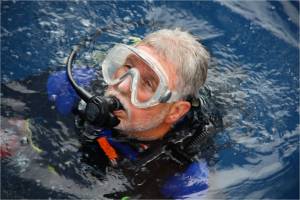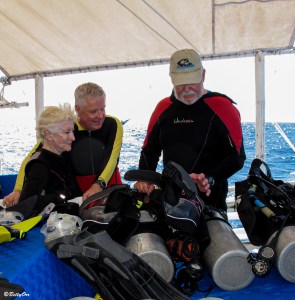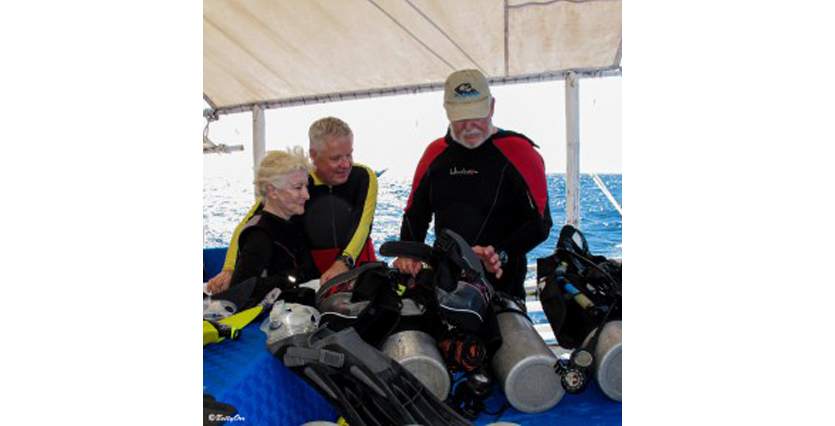I had the opportunity to listen to the live broadcast of the meeting of the National Transportation Safety Board (NTSB) where they discussed the results of their investigation into the tragic fire aboard the dive boat, Conception, where 34 divers lost their lives. During the meeting’s 4+ hours of discussion, they reviewed all aspects of the incident as they were preparing their final report and recommendations. There were a number of issues identified as board members and committee heads discussed details, some very hard to listen to, of things that contributed to the catastrophic loss of life.
Of all the things that were discussed, “normalization of deviance” struck a chord with me. I saw that it had direct application to diving safety leading me to the creation of this article. Normalization of deviance means that people become so accustomed to a conscious deviation from a standard procedure that they no longer consider those changes as being deviant.
 During my nearly 50 years as a diving professional and 23 years working at Divers Alert Network (DAN), I have read and reviewed many diving accident reports involving divers from all over the diving world. Understanding what turned an enjoyable recreational dive into a tragedy is an important step in learning how to avoid the same fate. To quote Eleanor Roosevelt, “Learn from the mistakes of others. You can’t live long enough to make them all yourself.” Many case reports detail a series of actions and habitual behaviors, which appear so far beyond comprehension that they defy our definition of “diver error.”
During my nearly 50 years as a diving professional and 23 years working at Divers Alert Network (DAN), I have read and reviewed many diving accident reports involving divers from all over the diving world. Understanding what turned an enjoyable recreational dive into a tragedy is an important step in learning how to avoid the same fate. To quote Eleanor Roosevelt, “Learn from the mistakes of others. You can’t live long enough to make them all yourself.” Many case reports detail a series of actions and habitual behaviors, which appear so far beyond comprehension that they defy our definition of “diver error.”
In 2008, Dr. Petar Denoble at DAN, reviewed nearly 1,000 diver fatalities. Part of his research identified triggering events that initiated a cascade of circumstances that transformed an otherwise enjoyable dive into a fatality were listed (Denoble, P., et al, “Causes of Recreational Diving Fatalities” UHM 2008, Vol. 35, No.6).
Those triggering events were:
- Out of Breathing Gas 41%
- Entrapment 21%
- Equipment Problems 15%
- Rough Water 10%
- Trauma 6%
- Buoyancy 4%
- Inappropriate Gas 3%
Looking at this data, you can see that over 60% of the identified triggering events (Out of Breathing Gas, Equipment Problems, Buoyancy and Inappropriate Gas) were either directly or indirectly related to equipment preparation and use. Before going any further, let me comment on one of the triggering events, “Equipment Problems.” From my experience and the review of the circumstances surrounding diving fatalities, I believe that “Equipment Problems”. is more likely to be “Problems with Equipment.” In other words, user error rather than a flaw in the equipment design. Using a checklist and a consistent pre-dive ritual can increase the likelihood of identifying and correcting errors before diving. The problem seems to be that divers, even some with extensive diving experience, may decide to take short cuts or deviate from standard safety procedures due to some sense of time pressure, complacency or just feeling that standard procedures may not apply to them.
DAN’s Annual Diving Report has interesting data regarding experience levels for diving fatalities. One graph (below) shows the number of openwater dives a diver has done within the 12 months preceding a diving fatality. In the graph below, you will see two distinct spikes in the number of fatalities. One spike involves divers with fewer than 20 openwater dives. This spike in the number of fatalities might be explained by the fact that these divers have limited experience in openwater diving, and their skills may not be sufficient to appropriately deal with a crisis underwater. Another spike in the same graph shows an increased number of fatalities with divers that have made more than 300 openwater dives in the months preceding a diving fatality. It may seem incredulous that divers with that much recent experience would get themselves in a situation where something occurred that initiated a series of events from which they could not recover.

One possible explanation for a high number of fatalities among very experienced divers could be that they may have routinely deviated from standard safety procedures so frequently that these deviations became “normalized” because in all previous instances nothing occurred reinforcing the use of these shortcuts. Even then, the question that should come to mind is how can trained, equipped, and experienced divers, with more than 300 individual diving experiences in the 12 months preceding their death in a diving accident, get themselves into a situation where their skills, abilities and equipment were not sufficient for them to survive an underwater diving emergency.
Reading through the details of many of these “accidents” found in the annual DAN Diving Accident Reports, causes you to naturally reflect on your own diving experiences and makes you realize that this could happen to you, just as it has happened to a number of highly trained, experienced and apparently qualified divers.
Clearly any of the divers found in the DAN annual Diving Reports were fully capable of following proper diving procedures and had done so on many previous openwater dives. When giving seminars on diver safety, one concept that is always brought up is “complacency” as one possible contributing factor in diving accidents. This is certainly true in many cases, but there may be another explanation, “normalization of deviance.” Normalization of deviance, in this case, means that certified and qualified scuba divers may have become so accustomed to a conscious deviation from standard diving and safety procedures that they no longer consider them as being a departure from the norm. Divers grow more accustomed to the deviation from standard procedures the more frequently they use them. To others, the deviation from a standard procedure would be seen as incorrect but to the diver, and possibly even others they regularly dive with, the incorrect procedure might seem like a normal part of the diver’s diving skills. When a deviation is made and the outcome is successful without any negative consequences, it subliminally reinforces the use of that deviation. In other words, the diver may experience a subconscious reward for doing the wrong thing because it worked.
The term “normalization of deviance” was coined by sociologist and Columbia University professor Dr. Diane Vaughn in her book, The Challenger Launch Decision. She detailed the decisions made by NASA that led to the Space Shuttle Challenger explosion in 1986. There had been problems with the “O” rings in the solid rocket boosters on previous launches without incident. Therefore, it became “normal operating procedure” to make launch “Go” decisions with identified issues with the “O” rings. NASA, unfortunately, did not learn from the Challenger disaster and fell victim to it again when the Space Shuttle Columbia disintegrated when the heat shield failed upon re-entry in 2003. Apparently, there had been heat shield issues during previous re-entries without serious incident, again, leading to issues with the heat shield being considered within “normal” operating parameters.
In order to learn from these space flight tragedies and other, more recent, catastrophic incidents within the diving world, we should fully understand the dangers from deviations from safe operating procedures when they become “normalized.” The first step in avoiding “normalization of deviance” is awareness. In diving safety, we discuss the concept of “situational awareness.” Situational awareness is where we are constantly monitoring those things going on as we prepare for a dive, during the dive and afterwards. This includes the pre-dive period as our diving companions are preparing and configuring their equipment. During the dive as we monitor our depth, bottom time, breathing gas consumption and anytime changes occur that could increase our risk during a dive. Post-dive as we observe our diving companions looking for signs of issues that could have been the result of the dive. When we identify anything that could negatively impact our diving experience, our knowledge and skills should alert us to take some sort of action.
Pre-dive equipment review
 There are many factors which may increase the likelihood of normalization of deviance. For example, there are divers, even those with lots of experience, who often develop shortcuts or neglect proper procedures, including those steps found on accepted checklists from training programs, or even those considered as standard safety procedures. The justification for conscious rule breaking often comes where the rule or standard is perceived as ineffectual. In charter boat or liveaboard diving, time pressure may be an issue that would seem to justify skipping a few steps that may be considered inconsequential. Saving a few minutes in preparation may seem to be the right thing to do when others are waiting for you but would seem less important when things go terribly wrong once in the water. Divers may also learn a deviation without actually realizing it. Diver training only covers part of what a diver needs to know to dive, especially in some of the more challenging diving situations. Some divers will adopt modifications from other, apparently more experienced, divers that have worked for them in similar situations. They may do this without questioning or completely evaluating these modifications in procedures. And, finally, diving in a culture that permits mistakes to go uncorrected. There is a popular saying nowadays, “See something, say something.” This philosophy may certainly have value in terms of accident prevention. Diving companions may be afraid to speak up when they see something about a pre-dive preparation or even a diving skill that deviates from proper procedures or techniques. Even though we are certainly not our brother’s keeper, we do have an obligation to our diving companions to help identify something just doesn’t seem right and thus, preventing an accident. There is no problem with simply asking questions about something that is different than what we expect or different than what we’ve seen before. In fact, it is a way we may learn. You may have actually discovered a new and better way of doing something or you may have brought an error to the attention of a fellow diver, possibly preventing an unfortunate situation from occurring. One caution, however: never take anything at face value when it comes to diving or safety. Evaluate anything that is different from what you know to be correct and ask others with more experience or expertise
There are many factors which may increase the likelihood of normalization of deviance. For example, there are divers, even those with lots of experience, who often develop shortcuts or neglect proper procedures, including those steps found on accepted checklists from training programs, or even those considered as standard safety procedures. The justification for conscious rule breaking often comes where the rule or standard is perceived as ineffectual. In charter boat or liveaboard diving, time pressure may be an issue that would seem to justify skipping a few steps that may be considered inconsequential. Saving a few minutes in preparation may seem to be the right thing to do when others are waiting for you but would seem less important when things go terribly wrong once in the water. Divers may also learn a deviation without actually realizing it. Diver training only covers part of what a diver needs to know to dive, especially in some of the more challenging diving situations. Some divers will adopt modifications from other, apparently more experienced, divers that have worked for them in similar situations. They may do this without questioning or completely evaluating these modifications in procedures. And, finally, diving in a culture that permits mistakes to go uncorrected. There is a popular saying nowadays, “See something, say something.” This philosophy may certainly have value in terms of accident prevention. Diving companions may be afraid to speak up when they see something about a pre-dive preparation or even a diving skill that deviates from proper procedures or techniques. Even though we are certainly not our brother’s keeper, we do have an obligation to our diving companions to help identify something just doesn’t seem right and thus, preventing an accident. There is no problem with simply asking questions about something that is different than what we expect or different than what we’ve seen before. In fact, it is a way we may learn. You may have actually discovered a new and better way of doing something or you may have brought an error to the attention of a fellow diver, possibly preventing an unfortunate situation from occurring. One caution, however: never take anything at face value when it comes to diving or safety. Evaluate anything that is different from what you know to be correct and ask others with more experience or expertise
Resisting the tendency to deviate from proper procedures or techniques that were developed to keep our sport and divers safe requires a willingness from every diver to always follow the skills, techniques and procedures that they were taught. One approach to combatting deviations from safe diving procedures is to develop and maintain a culture of diving safety. A safety culture is the enduring value and priority placed on safety by every diver at every level. All divers must commit to personal responsibility for safety; preserve, enhance, and communicate safety concerns as soon as they are identified; actively learn from past mistakes and the mistakes of others and apply safe behaviors based upon lessons learned. Anything less than a full commitment to a safety culture would allow deviations from proper procedures or techniques to become part of normal operating procedure that will, possibly, lead to a tragic outcome from what should be a truly wonderful diving experience.
In order to address accidents in the use of closed-circuit rebreathers (CCRs), the technical diving community came together in 2012 at Rebreather Forum 3.0 and developed a series of recommendations to improve CCR safety. One of these recommendations was the use of checklists. The use of checklists, however, should not be confined to rebreather diving. The use of a checklist to reduce the likelihood that some critical aspect of pre-dive preparation is not missed should be an essential part of every diver’s repertoire. Unfortunately, diving accident data and post-accident diver interviews show that checklists may still not be considered part of many diver’s safety procedures. The lack of checklist use could, in many cases, have possibly prevented a tragedy but, not using a checklist was considered, by many, normal operating procedure. While checklists should be considered a standard part of every diver’s preparatory procedures, I would also suggest combining the use of a checklist with a consistent pre-dive ritual for equipment preparation. Getting into a strict routine will certainly help prevent equipment configuration and preparation errors.
Whether we are diving with friends, family, or others enjoying the same sport and dive site, we all want to enjoy the wonders of diving without ending up as a DAN statistic. We can all agree that a diving fatality is terrible for the sport, the industry and the loved ones that are left behind. Taking short cuts as a regular practice where these changes become “normalized” can certainly compromise our safety and the safety of our diving companions and risk taking away our most precious gift, life.
References:
Orr, Dan and Douglas, Eric. Scuba Diving Safety. Best Publishing Company. 2007
Vaughn, Diane, PhD. The Challenger Launch Decision: Risky Technology, Culture, and Deviance at NASA. 1996.
Denoble, P., et al, “Causes of Recreational Diving Fatalities” UHM 2008, Vol. 35, No.6
Annual Diving Report. Divers Alert Network. 2006.
Orr, Dan. The Normalization of Deviance aka The Shortcut Mentality. DeeperBlue.com. March 3, 2021.


